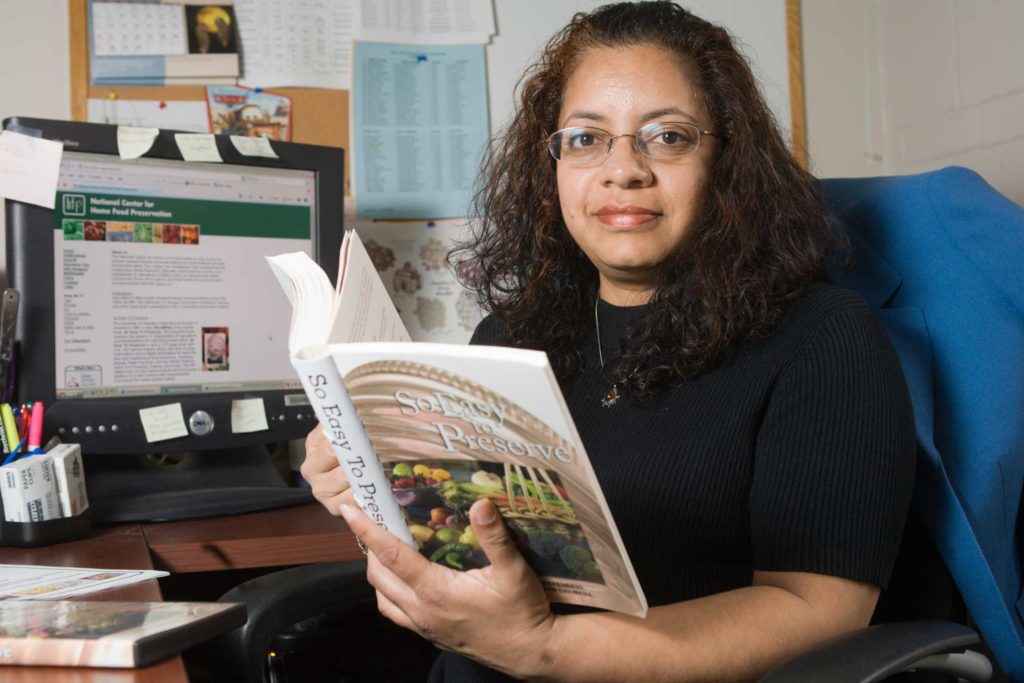Elaine D’Sa spent hours during her childhood discussing microbiology, medicine and microorganisms with her father, Joe D’Sa, a medical microbiologist. Her fascination with this invisible world convinced D’Sa to dedicate her life to science.
She now has three degrees related to microbiology and works as a research coordinator II with the National Center for Home Food Preservation in UGA’s department of foods and nutrition’s Cooperative Extension at the College of Family and Consumer Sciences.
“I just love it,” said D’Sa. “I like the subject area and the fact that there’s that whole world out there that’s invisible but can have such a great impact on our lives.”
She moved to Athens in 1995 from India to pursue a doctoral degree in food microbiology.
“I had always wanted to specialize in food microbiology and the way pathogens survive in and are transmitted through foods,” she said. “UGA has an excellent food microbiology program in the department of food science and technology, and I think that really directed my path here.”
Before coming to UGA, D’Sa attended the University of Bombay (now the University of Mumbai) in India, where she earned both her bachelor’s and master’s degrees. After graduating, she taught microbiology, biochemistry and the principles of food processing and preservation for eight years at the university.
D’Sa began working with NCHFP during graduate school, and after earning her doctorate in 2002, took a position with the center.
The NCHFP, a U.S. Department of Agriculture funded National Center, and UGA’s Cooperative Extension, is dedicated to providing educators in Georgia and nationwide with recommendations on how to safely and efficiently preserve foods by home canning, freezing, drying, curing and smoking, fermenting, pickling or making jams and jellies.
A main part of D’Sa’s job involves answering questions from consumers and educators about the safety and methods of food preservation, as well as conducting research to develop new science-based recommendations for foods preserved at home.
The task can be a challenge, especially in the spring and summer months, which is peak food preserving season. D’Sa said that the NCHFP receives as many as 20 requests a day during these months.
“We get overloaded by information requests and work long hours trying to keep everyone happy,” she said. “Also, at this time, we are doing our own research.”
When canning foods at home, certain processes need to be followed to prevent underprocessing, and the consequent risk of foodborne disease (like botulism, a serious illness that can be fatal) and food spoilage, D’Sa said,
For canning, two different processes are used, depending on the acidity of food. A pH of 4.6 or below (high acidity) is needed to prevent the bacteria causing botulism from growing.
A boiling water bath canner, where jars are processed for the recommended time in boiling water to be preserved, is used for foods that have a pH below 4.6, including jams and jellies, pickled foods and most fruits. A pressure canner, which reaches higher temperatures through the use of steam, is used to preserve low-acid foods (with a pH higher than 4.6) , including poultry, meats and vegetables.
After the jars are heat processed, they must sit for up to 24 hours, D’Sa said, to make sure the lids seal. More information on how to preserve food, D’Sa said, can be found on the NCHFP Web site at www.uga.edu/nchfp.
“Our aim is to help people preserve canned foods so as to maximize quality while, at the same time, making food safe for them to consume and store on a shelf,” D’Sa said.
During May term, D’Sa also will teach a course, “Principles of Processing and Preserving Food at Home,” which lets students take a hands-on approach to the art of canning, drying, freezing and preserving food.
D’Sa, who does can some of her own food-mostly jams and jellies-said that what she appreciates the most about her job is the interaction she has with consumers and educators.
“I like the fact that the Cooperative Extension system is something where you can make research findings available to consumers,” she said. “We can bridge the gap between research and educating consumers, and that is exciting.”
